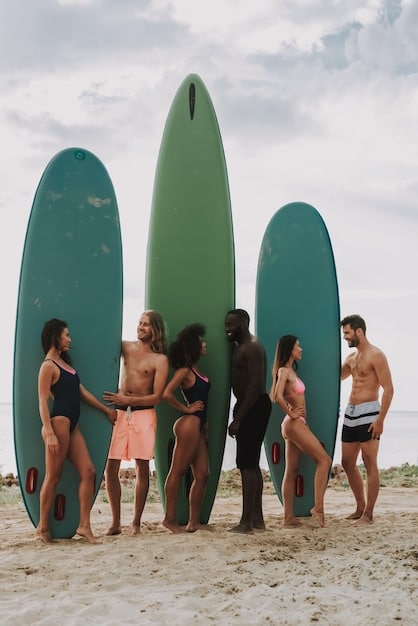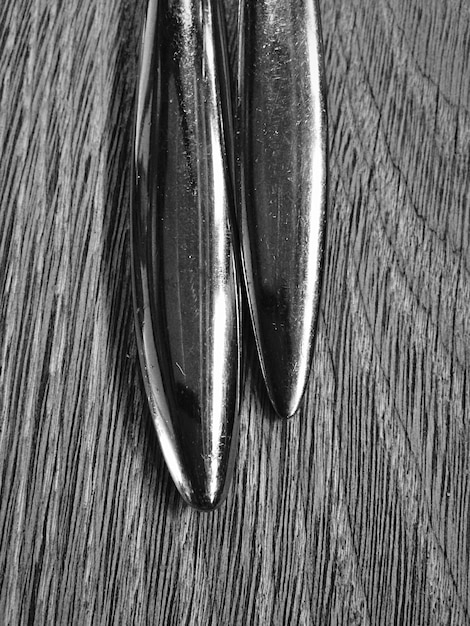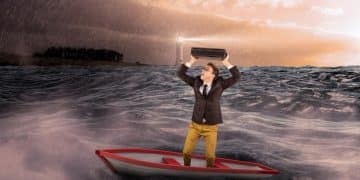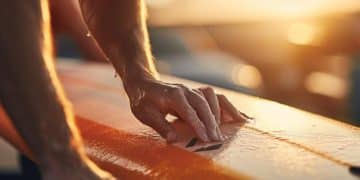Choosing the Right Surfboard for US Waves: 2025 Guide

Navigating the complexities of surfboard selection for U.S. waves in 2025 demands a precise understanding of rider weight, wave height, and board volume to optimize performance and enjoyment for surfers of all levels, ensuring a tailored fit for diverse conditions from East Coast breaks to Pacific swells.
Embarking on the quest to find the perfect surfboard can feel daunting, especially with the vast array of options available and the specific nuances of wave conditions across the United States. This how to choose the right surfboard for US waves: a 2025 guide based on rider weight and wave height aims to demystify the process, providing clear, actionable insights for both novice and experienced surfers looking to elevate their ride in 2025.
Understanding the US Wave Landscape and Its Impact on Board Choice
The United States boasts an incredibly diverse coastline, from the often-milder, longer period swells of the East Coast to the powerful, frequently hollow waves of the Pacific. Each region presents its own unique challenges and opportunities for surfers, directly influencing the optimal surfboard dimensions and design.
For instance, the consistent, yet sometimes less powerful waves found in areas like Florida or the Carolinas might favor boards with more volume and flatter rockers to maximize paddle power and wave catching. Meanwhile, the steep, fast-breaking waves of Southern California or the barreling giants of Hawaii demand quicker response, precise turning, and often less volume for control.
East Coast vs. West Coast vs. Gulf Coast Perspectives
The dynamic nature of U.S. waves means a single board rarely suits all conditions perfectly. East Coast waves, influenced by offshore storms and hurricanes, can be punchy but often lack sustained power, suggesting boards with ample buoyancy and easier paddling. West Coast waves, particularly in California and the Pacific Northwest, benefit from deep ocean swells, leading to more consistent and powerful surf, conducive to performance-oriented boards.
- East Coast: Often requires boards with higher volume for easier paddling and wave catching in softer, less consistent waves.
- West Coast (California): Benefits from versatile boards that can handle a range of conditions, from mellow beach breaks to more critical reef passes.
- Pacific Northwest/Northern California: Demands robust boards for colder, heavier waves and strong currents.
- Hawaii: Specializes in high-performance, durable boards for powerful, often barreling, world-class waves.
- Gulf Coast: Typically needs maximum volume and efficient designs for extremely small, often wind-generated waves.
The Gulf Coast, while less renowned for surf, still offers opportunities, albeit demanding boards that can generate speed from minimal wave energy. Therefore, understanding the general characteristics of your primary surf spot is paramount before diving into board specifics.
This geographical understanding forms the bedrock of an informed surfboard choice. It’s not just about what feels right, but what performs optimally in the specific conditions you’ll encounter most often. Selecting a board that complements your local waves will significantly enhance your learning curve and overall enjoyment.
Decoding Surfboard Volume: The Core of Your Ride
Surfboard volume, often expressed in liters, has become the single most critical metric for matching a board to a surfer. It encapsulates the board’s buoyancy and greatly influences its paddle power, stability, and maneuverability. No longer is length the sole determinant; volume offers a more precise measurement that directly correlates with a surfer’s ability and the wave’s characteristics.
A higher volume board provides more float, making it easier to paddle into waves and offering greater stability once you’re up. This is particularly beneficial for beginners, heavier surfers, or those surfing smaller, weaker waves. Conversely, a lower volume board offers less float but allows for quicker rail-to-rail transitions and more radical maneuvers, making it ideal for experienced surfers in powerful waves.
The Volume sweet spot: a personalized approach
Finding your ideal volume is a blend of science and personal preference. There are general guidelines based on rider weight and skill level, but ultimately, it’s about what feels good underfoot. For a beginner, a generous volume simplifies the learning process. As skills advance and confidence grows, surfers often gravitate towards lower volumes for greater responsiveness.
- Beginners: Aim for higher volume (e.g., 0.4-0.6 liters per kilogram of body weight) for stability and ease of paddling.
- Intermediates: Can reduce volume slightly (e.g., 0.35-0.45 liters/kg) for improved maneuverability while maintaining paddle power.
- Advanced: Opt for lower volumes (e.g., 0.3-0.35 liters/kg) for maximum performance and quick responsiveness in critical sections.
Consider your personal attributes: your fitness level, how often you surf, and your specific local wave conditions. A surfer who surfs infrequently might benefit from a bit more volume to compensate for reduced paddle fitness. Similarly, someone consistently surfing weak waves will appreciate the added float.
Volume is not just a number; it’s the key to unlocking your surfing potential and ensuring countless hours of enjoyable wave riding. It’s the balance point between effortless wave catching and dynamic performance, tailored to your unique surfing profile.
Rider Weight and Skill Level: Your Personal Surfing Blueprint
Your body weight directly correlates with the amount of volume you need in a surfboard to achieve adequate buoyancy. This is a fundamental principle that often gets overlooked, leading to frustration in the water. A board that’s too small for your weight will be difficult to paddle and unstable, while one that’s too large might feel cumbersome and slow to turn.
Beyond weight, your skill level plays an equally crucial role. Beginners require more stability and paddle power, which translates to higher volume. As you progress, your balance improves, your paddle technique becomes more efficient, and your ability to generate speed and execute turns evolves, allowing you to reduce volume and ride more performance-oriented shapes.

Matching volume to your progression
Think of your surfboard as an extension of your body. As your skills advance, so should the board’s responsiveness. A gradual decrease in volume as you improve ensures a smooth transition and continued progression. Jumping too quickly to a low-volume, high-performance board can hinder development and lead to perpetual struggle.
- Beginner (Learning to Stand): Focus on stability and paddle power. Look for foam boards, longboards, or high-volume funboards. Volume-to-weight ratio is high.
- Novice (Consistent Take-offs, Straight Rides): Transition to more maneuverable longboards or funboards. Start understanding how to trim and control speed.
- Intermediate (Turning, Speed Generation): Explore mid-length boards, hybrid shapes, and performance longboards. Begin experimenting with rail engagement.
- Advanced (Executing Critical Maneuvers, Tube Riding): Opt for shortboards, step-ups, and specialized performance boards. Volume is precisely tuned for maximum responsiveness.
It’s important to be honest about your skill level. Many surfers overestimate their abilities, choosing boards that are too challenging, which ultimately slows their progress. A slightly larger or more voluminous board can often accelerate learning by making the process more enjoyable and less fatiguing.
Ultimately, the synergy between your weight, skill, and board volume is what defines a successful session. A well-matched board provides the foundation for confidence and allows you to focus on improving your technique rather than struggling with basic mechanics.
Wave Height and Power: Adapting Your Quiver
The size and power of the waves you typically surf are perhaps the most influential factors after rider weight and skill. A board designed for small, weak waves will feel sluggish and unwieldy in powerful, overhead surf, while a high-performance board for big waves will be almost impossible to paddle and ride in knee-high slop.
In the U.S., wave heights vary dramatically. East Coast waves might average 2-4 feet, while a winter swell in Hawaii can easily push waves to 10-20 feet and beyond. Surfers often accumulate a “quiver” of boards, each designed for a specific range of wave conditions. This allows for optimal performance no matter what the ocean delivers.
Tailoring your board to the swell
For smaller, less powerful waves (1-3 feet), boards with flatter rockers, wider noses, and more volume are ideal. These characteristics help generate speed in mushy conditions and increase wave count. Think longboards, funboards, and fish shapes.
- Small to Medium Waves (1-4 feet):
- Longboards: Excellent for glide, trimming, and nose riding.
- Funboards/Mini-Mals: Great all-rounders, easier to paddle than shortboards.
- Fish Boards: Wide, low rocker, excellent for speed generation in weaker waves.
- Shortboards (high volume): Designed for speed and tight turns in punchy, small to medium waves.
- Medium to Large Waves (5-8 feet+):
- Performance Shortboards: Refined outlines, more rocker, designed for critical turns.
- Step-ups: Slightly longer and more volume than a standard shortboard, for bigger, hollower waves.
- Gun Shapes: Reserved for truly massive waves, specialized for speed and control in extreme conditions.
As wave height and power increase, surfers typically opt for boards with more rocker (curve from nose to tail), narrower outlines, and less volume. This design promotes control, allows for steeper drops, and facilitates holding a rail in powerful turns. A board that allows you to confidently drop into a pitching wave and hold a line is crucial for safety and performance in larger surf.
Considering the typical wave heights at your local breaks and how frequently you surf different conditions will guide your surfboard purchases. A versatile quiver, even if it starts with just one “daily driver” and one small-wave specialty board, can significantly enhance your surfing experience across the varied U.S. surf landscape.
Surfboard Types: A Comprehensive Overview for US Surfers
The world of surfboards is vast, but understanding the primary categories can simplify your selection process. Each type is designed with specific performance characteristics in mind, catering to different wave conditions and rider preferences. From the classic glide of a longboard to the high-performance agility of a shortboard, there’s a shape for every surf style in the U.S.
It’s beneficial to have a foundational understanding of what each board type offers before committing to a purchase. Your choice will directly impact your wave count, your ability to maneuver, and your overall enjoyment in the water.
Exploring the diversity of surfboard shapes
Let’s break down the most common surfboard types you’ll encounter on U.S. beaches:
Longboards: Typically 9 feet or longer, these boards offer maximum paddle power and stability. They are the easiest to catch waves on and are excellent for beginners, older surfers, or those who enjoy a graceful, flowing style. Ideal for small to medium-sized, mellow waves found on most U.S. beaches. They excel at nose riding and cross-stepping.
Funboards (Mini-Mals): Ranging from 7 to 8.5 feet, funboards are a great bridge between longboards and shortboards. They provide good paddle power and stability but are more maneuverable than longboards, making them perfect for progressing intermediates. They perform well in a wide range of small to medium U.S. waves, offering versatility.
Fish Boards: Characterized by their short, wide outline, flatter rocker, and swallow tail, fish boards are renowned for their speed and ability to glide across flat sections of waves. Excellent for small to medium, less powerful waves, they are a fun option when the waves are not ideal for a performance shortboard. Popular on both East and West Coasts for their ability to generate speed.
Hybrid/Egg Shapes: These are versatile boards that often blend features of fish and shortboards, typically 6-7.5 feet. They offer a good balance of paddle power and maneuverability, making them suitable for a broad spectrum of conditions and skill levels. A popular choice for a “one-board quiver” for many intermediate surfers in varied U.S. conditions.
Shortboards: Generally under 6.5 feet, shortboards are designed for high-performance surfing, quick turns, and airing. They require skill, good paddle fitness, and more powerful waves to unlock their full potential. Best suited for intermediate to advanced surfers on medium to large, powerful waves found on the West Coast or during good East Coast swells.
Guns/Step-ups: These are specialized boards for very large and powerful waves (8 feet+). Longer and narrower than standard shortboards, they provide the necessary stability and speed for steep drops and powerful turns in critical conditions. Primarily used by advanced surfers tackling big wave spots like Mavericks or Jaws.
Choosing the right type of board is about aligning the board’s design with your surfing ambitions and the typical conditions of your local break. Don’t be afraid to experiment or seek advice from experienced local shapers or surf shop employees.
Considering Board Construction and Fin Setup
Beyond the shape and volume, the materials and construction of a surfboard, as well as its fin setup, significantly impact its performance and durability. This technical dimension offers another layer of customization, allowing surfers to fine-tune their ride for specific conditions or personal preferences.
Understanding the basics of construction materials and fin configurations can empower you to make more informed decisions, enhancing your connection with the wave.
Material matters: PU, EPS, and beyond
The two primary types of surfboard construction are Polyurethane (PU) and Expanded Polystyrene (EPS), often glassed with polyester or epoxy resins, respectively.
- Polyurethane (PU): This is the traditional surfboard construction. PU boards are known for their smooth, damp feel in the water, offering a classic “connected” surfing experience. They tend to nose-dive less in choppy conditions and provide a stable ride. Often preferred by performance surfers in good waves.
- Expanded Polystyrene (EPS) with Epoxy Resin: EPS boards are lighter and more buoyant than PU, often making them easier to paddle and more responsive. They can feel “livelier” underfoot and are less prone to dinging, although they can sometimes feel chattery in turbulent conditions. Popular for small to medium wave boards and for travel due to their lighter weight.
- Other Constructions: Advanced constructions like carbon fiber reinforcements, various foam densities, and even hollow wooden boards offer unique feel and performance, though they are less common for the average surfer.
The choice between PU and EPS often comes down to personal feel and the general wave conditions you surf. For more critical turns and powerful waves, many still swear by PU. For lighter, faster, and more forgiving characteristics, EPS is a strong contender.
Fin setup: driving performance
The fin setup is critical for control, drive, and maneuverability. Common configurations include:
- Single Fin: Offers maximum drive, hold, and glide, making it ideal for longboards and retro shapes in clean, flowing waves. Provides a classic, soulful surfing experience.
- Twin Fin: Known for speed and a loose, skatey feel. Great for generating speed in small to medium waves and making rapid turns. Often seen on fish boards.
- Thruster (Tri-Fin): The most popular and versatile setup (three fins). Provides a balanced blend of speed, drive, and maneuverability. Suitable for all skill levels and a wide range of wave conditions, from small to large.
- Quad Fin: Offers a mix of speed (like a twin fin) and hold (like a thruster). Excellent for generating speed in hollow, barreling waves and provides a unique sensation of flow.
- 5 Fin Setup: Provides the option to run the board as a thruster or a quad, offering maximum versatility for different wave conditions.
Many boards today come with changeable fin systems, allowing you to experiment with different setups and tailor your board’s performance to specific waves or your evolving surfing style. Don’t underestimate the impact of fins; a swap can dramatically alter how your board feels on the wave.
Investing time in understanding these technical aspects will serve you well, transforming your surfboard from a simple piece of foam into a finely tuned instrument for wave riding.
Advanced Considerations and Future Trends for 2025
As we look to 2025, surfboard design and surfing technology continue to evolve, offering even more nuanced choices for the discerning surfer. Beyond the fundamental aspects of weight, wave height, and board type, there are several advanced considerations that can help optimize your performance and enjoyment.
Staying abreast of these trends can provide a competitive edge or simply enhance your experience, ensuring your quiver remains relevant and high-performing.

Hydrodynamics and board flex
Modern surfboard design increasingly focuses on hydrodynamics, including bottom contours, rail shapes, and rocker profiles, to manipulate water flow for maximum speed and control. Subtle changes in these areas can have profound impacts on how a board feels and performs.
- Bottom Contours: Single and double concaves, vee, and channels all influence water flow, providing lift, speed, or control. Understanding how these work can help you choose a board suited to your preferred style of surfing.
- Rail Shapes: Fuller rails offer more buoyancy and stability, making them forgiving. Sharper, lower rails penetrate the water more easily, providing more bite and control in powerful turns.
- Rocker: The curve of the board from nose to tail. More rocker provides maneuverability and allows for steeper drops but reduces speed. Flatter rockers are faster but less agile.
Board flex, influenced by construction materials and stringer configuration, also plays a role. A board with more flex can provide a lively, responsive feel, “pumping” through turns. Less flex offers more direct drive and control in powerful conditions. Shapers are constantly experimenting with these variables to create boards that respond optimally.
Sustainability and responsible choices
The environmental impact of surfboard manufacturing is also a growing concern. In 2025, more brands are focusing on sustainable practices, using eco-friendly resins, recycled foams, and local manufacturing processes. Choosing a board from a company committed to sustainability not only gets you a great board but also contributes to protecting the oceans we love to surf.
Furthermore, the rise of custom shaping and local board builders offers an unparalleled opportunity to get a board perfectly tailored to your individual needs and local wave conditions. Working directly with a shaper allows for a level of customization that off-the-rack boards simply can’t match, ensuring an optimal union of surfer, board, and wave.
As you plan your next surfboard purchase for 2025, consider these advanced elements. The right combination of design, construction, and environmental consciousness can propel your surfing to new heights while aligning with values that preserve the very environment that makes surfing possible.
Tips for Your 2025 Surfboard Purchase
Choosing a surfboard in 2025 is more than just picking a cool design; it’s about making an informed investment in your surfing journey. With so many options, it can be overwhelming, but following a few key tips can simplify the process and ensure you find the perfect match for your needs and the specific waves of the U.S. coastline.
Remember, the goal is to optimize your enjoyment and progression, not just to own the latest model. A well-chosen board becomes an extension of yourself in the water.
Navigating the market and making the best choice
Here are some essential tips to guide your surfboard purchase for 2025:
- Be Realistic About Your Skill Level: This is arguably the most crucial tip. Don’t buy a board that’s too advanced for you. A slightly larger, more forgiving board will accelerate your learning significantly more than one that’s too small and frustrating.
- Consider Your Local Wave Conditions: Think about the typical wave height, power, and type of break you surf most often. This should heavily influence your board’s volume, length, and shape.
- Trial Before You Buy (If Possible): Many surf shops and rental services offer demo programs. If you can, try out different board types and volumes before committing. This hands-on experience is invaluable.
- Don’t Be Afraid of Volume: Especially for recreational surfers or those living in areas with smaller surf, a bit more volume can dramatically increase your wave count and overall fun.
- Talk to Local Surfers and Shapers: Locals know their waves best. Get insights from experienced surfers or custom shapers in your area about what works well.
- Set a Budget: Surfboards can range widely in price. Determine what you’re willing to spend and look for the best quality and fit within that range. Consider second-hand options for great value.
- Think About Your Quiver: As you progress, you’ll likely accumulate a quiver of boards for different conditions. Your first board might be your “daily driver,” with subsequent purchases filling specific niches.
- Prioritize Durability: If you’re new or hard on your equipment, consider boards with more durable constructions (like epoxy) that can withstand more dings and impacts.
Ultimately, the “right” surfboard is the one that makes you want to get in the water and improves your surfing. Don’t get too caught up in trends or what others are riding. Focus on what feels right for you, your skill, and your waves.
A well-selected board for 2025 will provide countless hours of joy, helping you connect more deeply with the ocean and the exhilarating sport of surfing. Invest time in the decision, and you’ll reap the rewards.
| Key Factor | Brief Description |
|---|---|
| 📏 Rider Weight & Skill | Match board volume to your body weight and surfing proficiency for optimal stability and control. |
| 🌊 Wave Height & Power | Select board type and dimensions based on typical wave conditions at your primary surf breaks. |
| surfboard Volume | Crucial for paddle power and maneuverability; higher volume for beginners/small waves, lower for advanced/powerful waves. |
| 🏗️ Construction & Fins | Consider materials (PU vs. EPS) and fin setup (thruster, quad, etc.) for desired feel and performance characteristics. |
Frequently Asked Questions About Surfboard Selection
▼
Your weight directly dictates the necessary volume (in liters) for a surfboard to effectively float you and facilitate paddling. Heavier surfers require more volume for stability and wave-catching ease, particularly for beginners. Lighter surfers can manage lower volumes, allowing for greater maneuverability and response.
▼
Surfboard volume is the total displacement of water by the board, measured in liters. It’s crucial because it quantifies the board’s buoyancy, affecting paddle power, stability, and ease of turning. Higher volume aids wave catching and stability, while lower volume provides more critical turning and performance for skilled riders.
▼
No, due to the vast diversity of US wave conditions—from Florida’s gentle swells to Hawaii’s powerful barrels—a single universal surfboard is impractical. Surfers often build a “quiver” of boards, each optimized for different wave heights, power levels, and specific regional characteristics to maximize performance and enjoyment.
▼
Fin setups significantly impact a board’s drive, hold, and maneuverability. A single fin offers classic glide, twin fins provide speed and a loose feel, while the common thruster (three fins) balances all three attributes. Quad fins offer a mix of speed and hold, ideal for hollow waves. Different setups allow fine-tuning for specific conditions.
▼
PU (polyurethane) boards, using polyester resin, offer a traditional, damp feel, excellent for powerful waves. EPS (expanded polystyrene) boards, with epoxy resin, are lighter, more buoyant, and more responsive, often preferred for smaller waves or travel due to their durability. Each offers a distinct ride characteristic and varies in ding resistance.
Conclusion
Choosing the right surfboard for U.S. waves in 2025 is a nuanced endeavor, blending personal attributes with environmental realities. By understanding the intricate relationship between rider weight, skill level, wave height, board volume, and surfboard type, surfers can make informed decisions that significantly enhance their time in the water. The ultimate goal is to find a board that complements your unique surfing style and the specific conditions of your local breaks, paving the way for countless memorable rides across America’s diverse coastlines.





